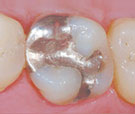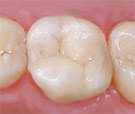Fillings- Amalgams and Tooth colored fillings
There are many types of filling materials available, each with their own advantages and disadvantages. You and your dentist can discuss the best options for restoring your teeth. Amalgam fillings, along with composite (tooth colored) fillings, are the most widely used today. An amalgam filling if used is never used on the front teeth.
As with most dental restorations, fillings though very durableare not permanent and will someday have to be replaced. They will however last many years, giving you a long lasting smile.
- Amalgam Filling
The classic “silver” filling has been in use for more than a century and the dental amalgam is actually an alloy made up of mercury, silver, tin, and copper. The mercury combines with the other metals in the amalgam to make it stable and safe. These fillings are strong but also quite noticeable. They also require relatively more tooth preparation (drilling) than other types.
A silver amalgam filling is used to repair a tooth that is affected by decay, cracks, fractures, etc. The decayed or affected portion of the tooth will be removed and then filled with a silver filling.

Reasons for amalgam fillings:
- Cracked or broken teeth
- Decayed teeth
- Worn teeth
What does getting an amalgam filling involve?
Amalgam fillings are usually placed in one appointment. While the tooth is numb, your dentist will remove decay as necessary. The space will then be thoroughly cleansed and carefully prepared before the new filling is placed. If the decay was near the nerve of the tooth, a special medication will be applied for added protection. The silver filling will then be precisely placed, shaped, and polished, restoring your tooth to its original shape and function.
It is normal to experience sensitivity to hot and cold when amalgam fillings are first placed, however this will subside once your tooth acclimates to the new filling.
You will be given post-care instructions at the completion of your treatment. Good oral hygiene practices, eating habits, and regular dental visits will aid in the life of your new fillings
- Tooth colored Fillings
Composite — A popular choice for those who don't want their fillings to show A composite (tooth colored) filling is used to repair a tooth that is affected by decay,cracks, fractures, etc. The decayed or affected portion of the tooth will be removed and then filled with a composite filling.Less drilling of the tooth is necessary when placing composite as compared to amalgam.
Because composite fillings are tooth colored, they can be closely matched to the color of existing teeth, and are more aesthetically suited for use in front teeth or teeth in the more visible areas of the mouth.

Reasons for composite fillings:
- Chipped teeth
- Closing space between two teeth
- Cracked or broken teeth
- Decayed teeth
- Worn teeth
How are composite fillings placed?
Composite fillings are usually placed in one appointment. While the tooth is numb, your dentist will remove decay as necessary. The space will then be thoroughly cleaned and carefully prepared before the new filling is placed. If the decay was near the nerve of the tooth, a special medication will be applied for added protection. The composite filling will then be precisely placed, shaped, and polished, restoring your tooth to its original shape and function.
It is normal to experience sensitivity to hot and cold when composite fillings are first placed, however this will subside once your tooth acclimates to the new filling.
You will be given care instructions at the conclusion of your treatment. Good oral hygiene practices, eating habits, and regular dental visits will aid in the life of your new fillings.